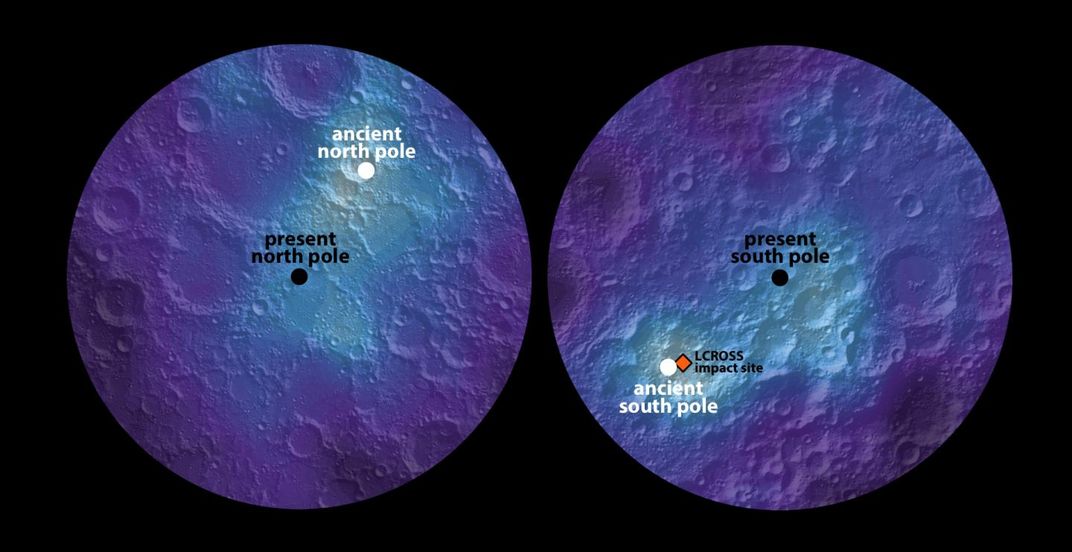Ancient Volcanoes May Have Shifted the Moon’s Poles
Ice deposits point to the moon’s old poles
/https://tf-cmsv2-smithsonianmag-media.s3.amazonaws.com/filer/59/aa/59aa2c6b-4f89-4cd8-a6ea-32f9e9f45634/moon_poles.jpg)
The moon may not have always spun at the same angle it does today. According to a new study, patches of water ice that formed in craters on opposite sides of the moon suggest that its axis may have shifted billions of years ago.
While the moon doesn’t have much in the way of geologic activity anymore, about three billion years ago it was pulsing with volcanic activity beneath its surface. A team of planetary scientists say that all that magma sloshing around in the moon may have shifted its axis, moving its poles about six degrees to where they are today, Dani Cooper reports for ABC Science.
"It would be as if Earth's axis relocated from Antarctica to Australia,” lead author Matthew Siegler, a researcher at the Planetary Science Institute, says in a statement. “As the pole moved, the Man [in] the Moon turned his nose up at the Earth."
Scientists have believed that the moon’s surface has patches of water ice in its shadowy regions since the 1990s, when NASA’s Lunar Prospector probe discovered traces of hydrogen. Lunar researchers have theorized that there are ice deposits still located in craters at the moon’s poles, which are permanently in shadow. However, according to the new study published in the journal Nature, when Siegler and his colleagues took a closer look at the poles they couldn’t find any traces of water ice. Because the ice should have accumulated over billions of years, Siegler suspects that some of the craters were at one time exposed to sunlight, Loren Grush reports for The Verge.
"The ice is like a vampire; as soon as it gets hit by sunlight, it poofs into smoke," Siegler tells Grush.
Meanwhile, Siegler and his team noticed that the water ice at the moon’s modern poles appears to trail off in mirroring directions. Also, Siegler found that each pole had a hydrogen-rich region a short distance away, which could mark the moon’s original, or “paleopoles.” By calculating the geologic changes that it would take to shift the moon’s axis, Siegler pinpointed the shift to a part of the moon called the Procellarum region; the center of almost all of the moon’s volcanic activity, Cooper reports.
"It takes a huge change in the mass of the Moon to do that—something like a giant crater or volcano forming," Siegler tells Cooper.

Siegler says that volcanic activity beneath the moon's surface about 3 billion years ago may have melted part of the moon's mantle, causing it to bubble up towards the surface. If enough mass shifted at that particular spot, it could have caused the moon to tilt on its axis, Grush reports.
The moon isn’t the only object in the solar system that scientists believe has experienced polar wander. Recently, researchers discovered that Mars may have experienced a similar event billions of years ago, when a massive volcanic region spewed so much magma that the Red Planet's surface shifted.
While more research must be done to determine how old the ice at the current poles is and how it formed, Siegler hopes that the findings will encourage NASA to send more probes to explore the moon’s poles in the future. Right now, NASA plans to send a rover to examine lunar ice in the 2020s, but for now does not expect to bring any samples back to Earth for study.
"The ice may be a time capsule from the same source that supplied the original water to Earth," Siegler says in a statement. "This is a record we don't have on Earth. Earth has reworked itself so many times, there's nothing that old left here. Ancient ice from the moon could provide answers to this deep mystery."